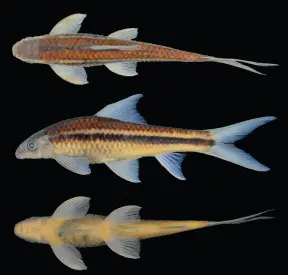Crossocheilus elegans
Etymology
Crossocheilus: from the Ancient Greek κροσσός (krossós), meaning ‘fringe, tassel’, and χείλος (cheílos), meaning ‘lip’, in reference to the barbels on the upper lip in members of this genus.
elegans: from the Latin elegans, meaning ‘elegant’.
Classification
Order: Cypriniformes Family: Cyprinidae
Distribution
Known only from the Segama and Kinabatangan river systems in Sabah state, eastern Malaysia (northern Borneo).
Type locality is ‘Danum Valley, Kinabatangan drainage, stream at km 111 on main line west after turnoff to Borneo Rainforest Lodge, 5°01’06.0″N, 117°32’38.4″E, Sabah, Borneo’.
Habitat
Mostly collected in or near riffle zones of headwater hill streams with fast-flowing water and rocky substrates.
Sympatric species include
Anguilla borneensis (Anguillidae), Garra borneensis, Hampala sabana, Lobocheilos unicornis, L. erinaceus, Paracrossochilus acerus, Schismatorhynchos holorhynchos, Tor tambra, T. tambroides (Cyprinidae), Gastromyzon aequabilis, G. danumensis, G. lepidogaster, G. ornaticauda, G. pariclavis, G. spectabilis, Homalopteroides stephensoni, Neogastromyzon crassiobex, Parhomaloptera microstoma (Balitoridae), Glyptothorax major (Sisoridae), and Macrognathus keithi (Mastacembelidae).
Maximum Standard Length
95 – 110 mm.
Aquarium SizeTop ↑
Minimum base dimensions of 150 ∗ 45 cm are recommended.
Diet
In nature Crossocheilus species are aufwuchs grazers feeding on algae, diatoms and other phytoplankton, plus associated microorganisms. The use of high-protein foods in the aquarium should therefore be avoided as the fish are unable to metabolise some components efficiently; regular, prolonged consumption can result in excessive deposits of fat and even organ degeneration.
A good quality dried product(s) with added Spirulina or similar is ideal but plenty of fresh vegetable matter should also be included in the diet. Shelled peas, blanched courgette, spinach and chopped fruit all make good additions to the menu. Once settled into the aquarium the fish sometimes ascend into midwater to feed and in a set-up as described above will often be seen browsing the biofilm that tends to form on the rockwork.
NotesTop ↑
This species can be most easily distinguished from other members of the genus by its colour pattern which consists of a blackish midlateral stripe extending from the tip of the gill opening to the middle of the caudal-fin base, which is separated from the dark brown dorsum by a pale yellowish brown stripe. This differs from the pattern seen in other Crossocheilus species with a black midlateral stripe in which the the dorsum is olive brown and much paler than the midlateral stripe, there is no yellow stripe between the dorsum and the black stripe, and the black stripe extends to the tip of the snout.
Prior to description it was referred to as Epalzeorhynchos kalliurus, currently a synonym of Crossocheilus cobitis, and later C. cobitis by certain authors.
Members of Crossocheilus are characterised by possessing 8 branched dorsal fin rays, immobile rostral lobes, lacking a dorsal spine and by the fact that the upper and lower lips aren’t connected, the upper being attached to the lower jaw via a thin membrane (Rainboth, 1996).
References
- Kottelat, M. and H. H. Tan , 2011 - The Raffles Bulletin of Zoology 59(2): 195-199
Crossocheilus elegans, a new species of fish from northern Borneo (Teleostei: Cyprinidae). - Kottelat, M., 2013 - The Raffles Bulletin of Zoology Supplement 27: 1-663
The fishes of the inland waters of southeast Asia: a catalogue and core bibiography of the fishes known to occur in freshwaters, mangroves and estuaries.

